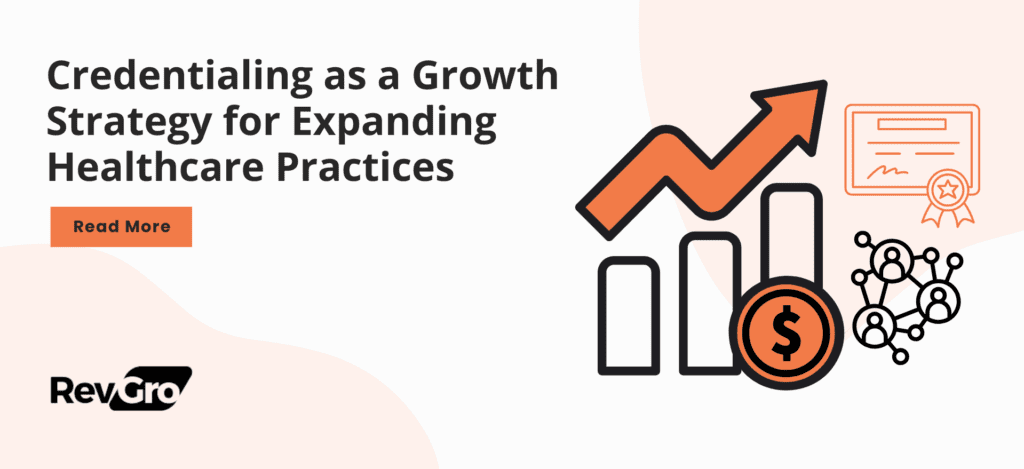
Credentialing as a Growth Strategy for Expanding Healthcare Practices
Table of Contents
- Introduction: The Role of Credentialing in Healthcare Growth
- The Credentialing Process: Building a Foundation for Growth
- Expanding Network Affiliations Through Credentialing
- Improving Patient Access to Care and Driving Revenue
- Streamlining Credentialing for Faster Growth
- Conclusion: Credentialing as a Long-Term Growth Strategy for Healthcare Practices
For healthcare practices looking to grow their reach, attract more patients, and increase revenue, the credentialing process often feels like an administrative hurdle. But it’s far more than just paperwork—it’s a foundational component of any successful practice. Credentialing can serve as a powerful growth strategy, helping healthcare providers join insurance networks, expand patient access, and drive revenue. In this blog, we’ll explore how credentialing contributes to the expansion and long-term success of healthcare practices.
As healthcare practices expand, they face a host of challenges—from maintaining regulatory compliance to building affiliations with insurance networks and improving patient access. Credentialing plays a key role in overcoming these obstacles. It’s the process that ensures healthcare providers meet the standards set by insurance companies and regulatory bodies, allowing them to join networks and serve a wider patient base.
Not only does credentialing impact patient care, but it also directly influences a practice’s growth and revenue. Without proper credentialing, providers may be unable to bill insurance companies, which limits the number of patients they can see and the revenue they can generate. In today’s competitive healthcare environment, efficient credentialing is essential for growth and long-term success.

Credentialing involves verifying a healthcare provider’s qualifications, including their education, certifications, licenses, and work history, to ensure compliance with insurance payors and regulatory bodies. It’s about confirming that providers are qualified to offer services and eligible to participate in insurance networks.
The process involves submitting applications to insurance companies, providing necessary documentation, and undergoing background checks. Getting it right from the start is crucial for practices that wants to grow. Mistakes or delays can prevent providers from enrolling in insurance networks, limiting patient access and slowing revenue growth.
When handled properly, credentialing paves the way for healthcare practices to broaden their services and reach more patients. It ensures compliance with regulations while allowing providers to tap into a larger pool of insured patients, which is essential for growth.
One of the key benefits of credentialing is that it allows healthcare providers to join multiple insurance networks. For growing practices, this is crucial—being credentialed with various insurers makes it easier for patients with different insurance plans to access care.
Broader network affiliations also raise a practice’s visibility within the healthcare community. As more insurance networks include your practice, you’re more likely to receive referrals from other healthcare professionals and specialists. This increased visibility helps build collaborations that enhance patient care and contribute to long-term growth.
Credentialing also strengthens referral networks. When your practice is credentialed across multiple insurance plans, it’s easier to collaborate with other specialists and hospitals that accept the same insurance. This leads to a more seamless care experience for patients and increases referrals, further supporting growth.
Credentialing is a key driver in increasing patient flow. When your healthcare practice is credentialed with multiple insurance companies, you become accessible to a wider range of patients—including those who rely on insurance to cover their healthcare costs. More patients translate directly into more revenue.
For practices serving underserved areas, credentialing can be a game-changer. By enrolling in programs like Medicaid and Medicare, which cater to lower-income populations, you can make your services more accessible to these communities. This not only fulfills a social responsibility but also increases your patient volume and revenue.
The link between credentialing and revenue growth is clear: if your practice isn’t credentialed, you can’t bill insurance companies. This means fewer patients and less income. By expanding your network affiliations, you’ll increase the number of patients you can serve, leading to more appointments, treatments, and ultimately, higher revenue.
For healthcare practices aiming to grow quickly, streamlining the credentialing process is essential. Technology can be a huge asset here. Credentialing software and automation tools reduce manual errors and help speed up the process, allowing providers to focus on patient care rather than paperwork.
Outsourcing credentialing to specialists is another way to accelerate growth. These experts understand the detailed requirements of different insurance companies and can manage the entire process on your behalf. This reduces the burden on your staff and helps avoid costly mistakes that could delay your practice’s expansion.
To ensure smooth credentialing, it’s important to keep all provider documentation up to date, proactively renew credentials before they expire, and maintain regular communication with insurance payors. Following these best practices minimizes disruptions in patient care and revenue flow due to credentialing issues.
Fewer delays and errors in credentialing translate to faster revenue generation. The sooner your practice is credentialed, the sooner you can start seeing patients from new insurance networks. Streamlining this process gives your practice a significant advantage when it comes to growth.
Credentialing isn’t just an administrative necessity—it’s a core growth strategy for healthcare practices. By ensuring your practice is affiliated with multiple insurance networks and expanding patient access, credentialing creates new opportunities for patient care and increases revenue. It supports both immediate expansion and long-term growth, ensuring your practice can thrive in a competitive healthcare environment.
Prioritizing credentialing helps healthcare practices maintain compliance, serve a broader patient base, and ultimately grow. In the fast-paced world of healthcare, the practices that streamline credentialing and focus on network affiliations will be best positioned for success.
If you want to expand your practice, grow your patient base, and ensure steady revenue flow, prioritizing credentialing is key. At RevGroMD, we understand the challenges you go through and hence are committed to bringing you all-inclusive credentialing services. Our team of experts is equipped with knowledge and geared with the right tools, set to drive the credentialing process efficiently and accurately in accordance with set timelines. For those considering outsourcing their credentialing services, we are here to help.
Contact us now to learn more about how we can support your practice and help you hit your goals.
